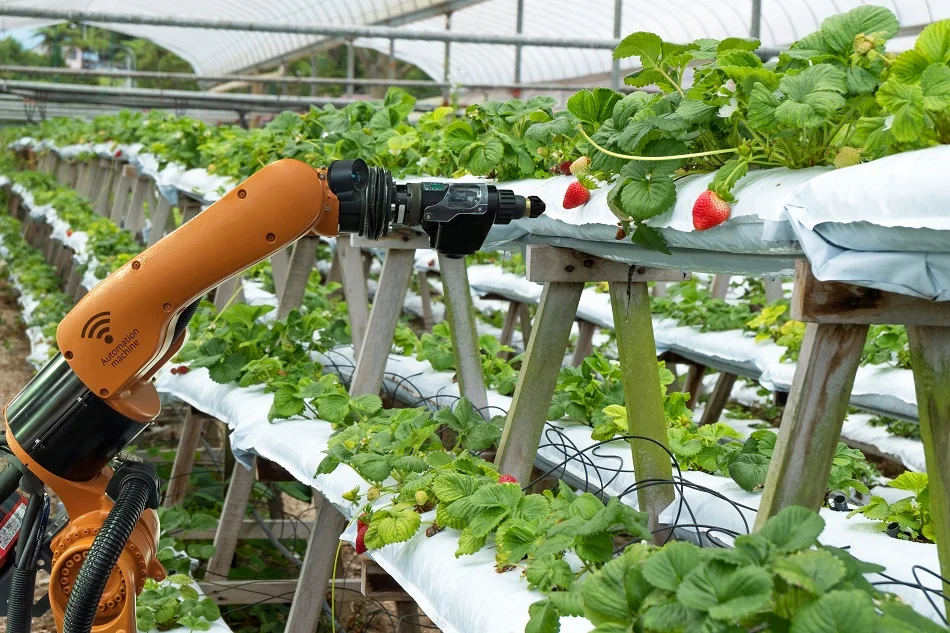Friday, 28 November 2025

Robotics and digital tools are slowly transforming the way farming is done. Robots are now being used for tasks like sowing seeds, spraying fertilisers, removing weeds, and even harvesting. These machines help save time, reduce manual work, and improve accuracy. At the same time, AI-based systems are making it easier to predict crop yields, monitor weather changes, and monitor crop health. However, with the land parcels becoming smaller and most Indian farmers owning less than a hectare of land, the need for low-cost innovations can be a game-changer.
The rising agricultural prospects in India are also seeing the entry of robots in the farming sector. A lot of research is being undertaken to transform traditional ways of farming and to know more on how robots can help farmers produce more crops.
The global agricultural robots’ market is projected to grow significantly, with an estimated value of $ 16.93 billion in 2025, reaching $31.33 billion by 2030, at a CAGR of 13.1 per cent during the forecast period (2025-2030). The Indian agricultural robots’ market was valued at $91.36 million in 2022, and is predicted to reach $544.35 million by 2030, with a CAGR of 23.6 per cent during the forecast period, 2023 – 2030.
Transformative role
Robotics applications are making remarkable impacts on Indian agriculture currently, being applied at every step, starting from seeding, transplantation/planting, judicious applications of inputs like fertilisers, pesticides, insecticides, herbicides, crop monitoring, irrigation, weeding, harvesting, and post-harvest sorting and processing.
Spraying robots, automated harvesters, drones, weeding robots, and smart sensors etc, are all contributing to the farming community. From precision agriculture, crop monitoring, irrigation management, pesticide and fertiliser application, and land surveying, farmers are adopting robots in farm lands to ensure data collection on crop health, growth, etc by utilising sensors, cameras, etc. It has significantly reduced the input required and labour cost (mostly in the large farm sector), leading to sustainability as being environmentally friendly.
Anurag Chaurasia, Scientist, ICAR-Indian Institute of Vegetable Research, Varanasi,remarks, “On one side, agricultural robotics applications are gladly being accepted in Indian states like Telangana, Punjab, Haryana, while on the other side, states like Bihar and Uttar Pradesh still have to catch up. Reducing the labour requirement, its applications significantly lower the input cost, leading to enhanced farmers’ income. I see a very bright future of agri-robotics in Indian agriculture (which includes Food processing industries too). It is re-attracting the youths towards agriculture, who otherwise were migrating to cities. Day by day, increasing labour cost and for environmentally friendly quality-based agriculture farming/produce, agri-robotics will certainly have a shining future in the Indian agro sector.”
Dr Jagannath Haridas Nirmal, Professor and Head of Department of Electronics Engineering, KJ Somaiya School of Engineering, KJ, Somaiya Vidyavihar University, Mumbai, observes, “The future of robotics in Indian agriculture depends on making technology accessible, not just advanced. While many farmers face financial constraints, they shouldn’t be excluded from this shift. The key lies in shared ownership models, equipment rentals, government subsidies, and collective platforms like FPOs. These approaches make robotics and automation more viable, even for small and marginal farmers. When designed with real farmers in mind, robotics and digital tech can reduce losses, boost productivity, and drive income, making the future of agri-tech inclusive, not exclusive.”
To read more, click: https://agrospectrumindia.com/e-magazine